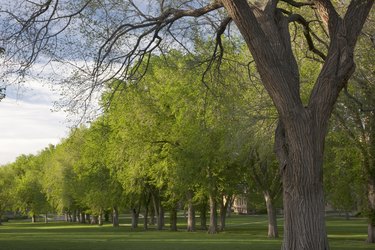
The American elm (Ulmus americana), also called white elm, is a native to the eastern United States, where it once lined the streets of many cities and towns because of its fast growth and arching, cathedral-like limbs. This hardwood tree grows in U.S. Department of Agriculture plant hardiness zones 2 to 9 and is prized for its interlocking wood that is hard to split, making it ideal for furniture making and construction projects.
Coveted for Its Shape
Video of the Day
The American elm commonly has a divided trunk near the base and vertical branches that sweep upward, giving it a vaselike shape that provides excellent shade coverage. It has oval-shaped leaves that grow up to 6 inches long, are toothed along the edges, alternate (meaning they are not across from each other) on the branch, and have deep veins that radiate out from the main vein in a V-shape. In autumn, leaves of this deciduous tree drop as the tree prepares for dormancy.
Video of the Day
Soil Type Affects Height
The American elm can adapt to a wide range of soil types and moisture conditions. It prefers well-draining, rich loam but also does well in poor-draining clays and dry, sandy soils. Soil type affects tree height. On average it grows to 80 feet high and 70 feet wide but grows to around 125 feet in rich, fertile soil and to only about 60 feet tall in dry soils. It does well in acidic or alkaline soil.
Decline of the American Elm
Dutch elm disease, introduced to the United States around 1930, led to a devastating decline of the American elm. This fungus, spread by bark beetles (Scolytus multistriatus), disrupts the tree's ability to transport water, leading to wilt and severely shortening its lifespan from more than 150 years on average to a mere 30 years. The American elm and some of its cultivars are also susceptible to phloem necrosis, the bacterial disease wetwood, rots and insect damage.
Resurgence of the American Elm
The development of cultivars resistant to Dutch elm disease makes planting American elm appealing again. Two such cultivars are Ulmus americana "Princeton," which is hardy in USDA zones 3 to 9 and grows up to 70 feet, or Ulmus americana "Valley Forge," hardy in USDA zones 5 to 9. Even with their disease resistance, a pruning and spraying program is recommended to prevent infection. When planting this ornamental shade tree, find a space that receives full sun and allows for tree spread. You can start new trees by cuttings taken from new branch growth and treated with a rooting hormone containing indolebutyric acid. Cuttings taken from the tree in its deciduous state will not root. The American elm has a low invasive potential.